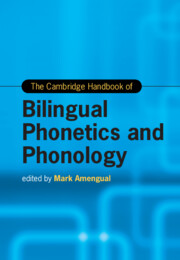Book contents
- The Cambridge Handbook of Bilingual Phonetics and Phonology
- Cambridge Handbooks in Language and Linguistics
- The Cambridge Handbook of Bilingual Phonetics and Phonology
- Copyright page
- Dedication
- Contents
- Figures
- Tables
- Contributors
- Acknowledgments
- Introduction Bilingual Phonetics and Phonology
- Part I Approaches to Bilingual Phonetics and Phonology
- Part II Theoretical Models of Bilingual Phonetics and Phonology
- Part III The Phonetics and Phonology of the Bilingual Child
- Part IV The Phonetics and Phonology of the Bilingual Adult
- 17 The Speech Perception of Bilingual Adults
- 18 The Speech Production of Bilingual Adults
- 19 Phonological Processing and Lexical Encoding in Bilingual Speech
- 20 Acquisition of Segmental Phonology in Adult Bilingualism
- 21 Acquisition of Suprasegmental Phonology in Adult Bilingualism
- Part V The Diversity of Bilingual Speakers
- Part VI Variables and Outcomes of Bilingual Speech
- Index
- References
20 - Acquisition of Segmental Phonology in Adult Bilingualism
from Part IV - The Phonetics and Phonology of the Bilingual Adult
Published online by Cambridge University Press: 14 November 2024
- The Cambridge Handbook of Bilingual Phonetics and Phonology
- Cambridge Handbooks in Language and Linguistics
- The Cambridge Handbook of Bilingual Phonetics and Phonology
- Copyright page
- Dedication
- Contents
- Figures
- Tables
- Contributors
- Acknowledgments
- Introduction Bilingual Phonetics and Phonology
- Part I Approaches to Bilingual Phonetics and Phonology
- Part II Theoretical Models of Bilingual Phonetics and Phonology
- Part III The Phonetics and Phonology of the Bilingual Child
- Part IV The Phonetics and Phonology of the Bilingual Adult
- 17 The Speech Perception of Bilingual Adults
- 18 The Speech Production of Bilingual Adults
- 19 Phonological Processing and Lexical Encoding in Bilingual Speech
- 20 Acquisition of Segmental Phonology in Adult Bilingualism
- 21 Acquisition of Suprasegmental Phonology in Adult Bilingualism
- Part V The Diversity of Bilingual Speakers
- Part VI Variables and Outcomes of Bilingual Speech
- Index
- References
Summary
This chapter examines the acquisition of vowels and consonants in perception and production during typical second language (L2) acquisition by sequential, dominant bilinguals. The acoustic and articulatory studies reviewed serve to illustrate general patterns of L2 segmental learning with a focus on four principal themes, each structured around one or two main research questions: 1) cross-linguistic influence (How does a sequential, dominant bilingual’s first language shape L2 segmental perception and production?); 2) development (Are there universal patterns to L2 segmental speech development? Are certain vocalic and consonantal phenomena acquired more easily?); 3) inter- and intralearner variability (What are the sources of differences in perception and/or production between learners and for the same learner over time and in different communicative contexts?); and 4) training effects (What are the effects of training on learning? How do variables such as task and stimuli type condition effectiveness?).
Keywords
- Type
- Chapter
- Information
- The Cambridge Handbook of Bilingual Phonetics and Phonology , pp. 448 - 470Publisher: Cambridge University PressPrint publication year: 2024

